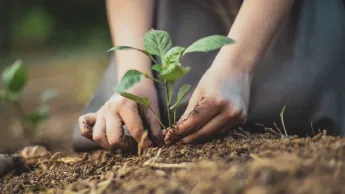We spoke with Diana Chaplin, the Canopy Director of One Tree Planted, a nonprofit on a mission to make it simple for anyone to help the environment by planting trees. Her role is focused on managing communications, marketing, and storytelling around the many reforestation projects that the organization conducts. She's a holistic thinker who helps scale the impact of One Tree Planted's work. Diana is fortunate enough to live among the woods and believes that all people should have access to healthy and thriving forests.
1014: Trees are vital for the environment, for example helping clean the air, filtering the water and providing habitat to over 80% of the world's terrestrial biodiversity. How do you at One Tree Planted assess the potential need for reforestation in North America and the world to protect “Life on Land”?
Diana Chaplin: We work with local partners on the ground to assess potential reforestation areas, typically after an environmental disturbance such a forest fire. Some things we look for are the impact the project will have on local communities, the availability of proper tree species for the area, the tools available to monitor the project after planting, and the long-term benefits for climate and biodiversity. The best timeframe, locations, and strategy for planting are also determined, which then culminate in reforestation plans. Due to significant deforestation globally, it can be a challenge to decide where to prioritize our resources, so we try to have diversity in the types of projects we support. Some have a focus on watershed health for community drinking water, others are planned for carbon sequestration, wildlife habitat expansion, or connecting disjointed forests after logging or mining operations. We ultimately look for projects that can have the biggest multi-level benefit for nature, people, and biodiversity.
1014: What is your mission, and how do you want to achieve it? How does One Tree Planted work? And how do people respond to your programs? What are some of the challenges you experience in your work? What do you like about it?
Diana Chaplin: Our mission is to make it simple for anyone to help the environment by planting trees. We fund planting projects around the world and share the impact each unique project will have. We also combine the skills and talents of ecologists, volunteers, storytellers, administrators, and many other contributors who play a unique role in executing reforestation projects at scale. The response has been overwhelmingly positive and we’re very grateful for the passionate supporters who make all this good work on the ground possible. Our model is one tree planted for every one dollar donated. This makes it possible for nearly anyone to plant a tree.
One challenge is just keeping up with the world! Sometimes, a lot happens in environmental news all at once, and we want to be on top of these areas that need attention with the right sense of urgency and tone while also continuing with restoration long after a story leaves the headlines. For example, the Australia bushfires that occurred in 2019/early 2020 are rarely mentioned these days, but the real work of long-term environmental restoration is just getting started. It’s important, and sometimes challenging, to keep up the momentum so that we can follow through on benefitting that ecosystem.
What we love about this work is teamwork and collaboration. It’s also incredibly rewarding to know that we’ve really made a difference when a project is completed.
1014: In an ideal world, what more do you think should be done to improve life on land, especially sustainably manage forests, halt land degradation and biodiversity loss?
Diana Chaplin: In an ideal world, whenever possible, green solutions will take the place of polluting industries and practices that harm the environment on a large scale. We need to wake up to the reality that our health and future depend on a thriving planet, and take collective actions top-down and bottom-up to halt the destruction of nature, replace fossil fuels with renewable energy, and preserve and restore the natural world.

